Commodore VIC-20 (ASSY 250403) Repair

Commodore VIC-20 Repair.
Defect:
- Black Screen.
Replaced parts:
- Replaced MOS VIA 6522 (UAB1)
- Replaced BASIC ROMS 901486-01 (UE11)
Gallery of the repair:

Commodore VIC-20 Repair.
Defect:
Replaced parts:
Gallery of the repair:
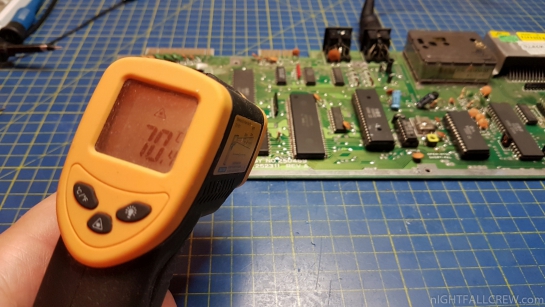
Commodore 64C (ASSY 250469) Repair
Defect:
Replaced parts:
Note:
Gallery of the repair:

What is DiagROM?
DiagROM is a diagnostic tool for the amiga computers.
And it is to be used on defective machines, trying to help no-boot situations etc.
You simply replace the Kickstart roms in the Amiga with the DiagROM. and when poweron. your Amiga will start a diagnostic software. It will try to dump info on the serialport (and actual menus etc aswell) while also trying on the screen.
Changelog:
Updatehistory:
Download: DiagoROM v1.0 Stable (1103)
source: diagrom.com

Jean-François DEL NERO (who’s behind the HxC SD Floppy Emulator) recently has released a version of the HxC emulator firmware that is compatible with the STM32 chip used in the Gotek floppy emulators.
This means that the great functionality of the HxC SD emulator is now available on cheaper and more widely available hardware.
The bootloader to convert the Gotek floppy drive in HxC compatible must be purchased on the website HXC 2001 by sending an email to Jean-François DEL NERO. The price of the bootloader is one-off 10 Euro per Gotek that you want to update. Future updates of the software are free and can be made from a USB stick
The HXC Usb (Gotek) firmware supports:  + many more….
+ many more….
Release notes Firmware USB HxCFloppyEmulator v3.0.33.4a:
This is only a little part of the changelog. The original one is very long and you can read it here.
Download: USB Stick STM32 (Gotek) HxC Firmware v3.0.33.4a (921)
source: hxc2001.com

Some new games or tools (Cracked / Trained or Unrealeased) for Commodore 64 have been released from your favorites groups.
Titles:
Download: All Games in One Archive (4846)
source: csdb.dk
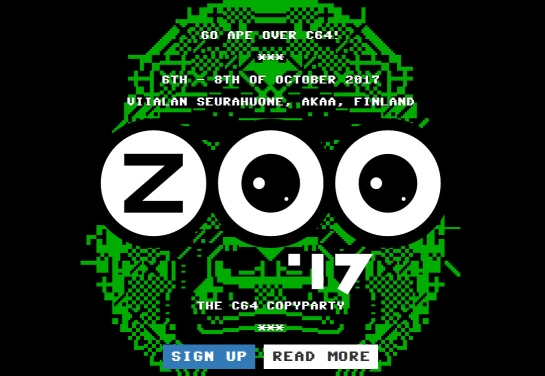
This is the official demo party results from ZOO 2017. See also the CSDB ZOO 2017 section for more informations and download.
C64 Demo:
C64 Music:
C64 Graphics:
WiLD Demo:
C64 Basic Demo:
C64 Disk Cover:
Mixed Graphics:
Productions released outside compos:
Download:
source: zooparty.org
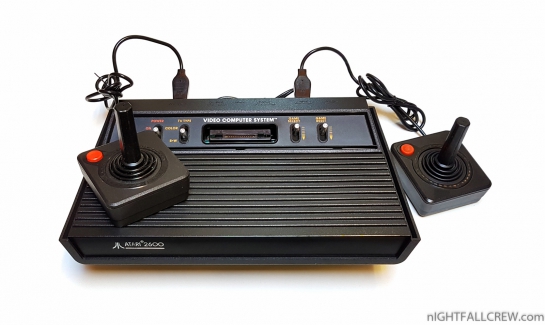
The Atari 2600 (or Atari Video Computer System before November 1982) is a home video game console by Atari, Inc. Released on September 11, 1977, it is credited with popularizing the use of microprocessor-based hardware and ROM cartridges containing game code, a format first used with the Fairchild Channel F video game console in 1976. This format contrasts with the older model of having non-microprocessor dedicated hardware, which could only play the games that were physically built into the unit.
For five years, 1977 until late 1982, the system was officially sold as the Atari VCS, an abbreviation for Video Computer System. Following the release of the Atari 5200 in November 1982, the VCS was renamed to the “Atari 2600″, after the unit’s Atari part number, CX2600. The 2600 was typically bundled with two joystick controllers, a conjoined pair of paddle controllers, and a game cartridge: initially Combat, and later Pac-Man.
Gallery:
source: wikipedia

A paddle is a game controller with a round wheel and one or more fire buttons, where the wheel is typically used to control movement of the player object along one axis of the video screen.
A paddle controller rotates through a fixed arc (usually about 330 degrees); it has a stop at each end.
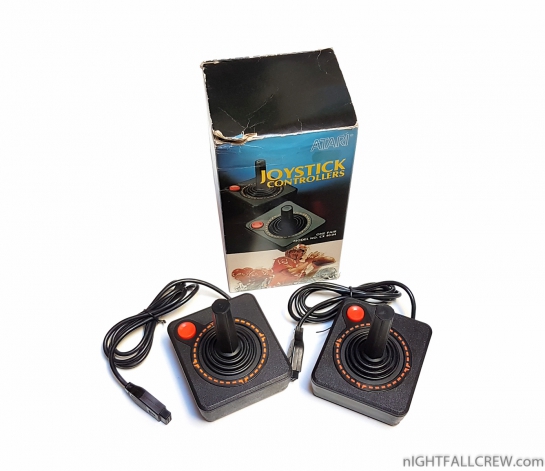
The Atari CX40 joystick was the first widely used cross-platform game controller. The original CX10 appeared on the Atari 2600 in 1977, and was considered such a great advance over other controllers that it became the primary input device for most games on the platform. The CX10 was replaced after a year by the much simpler and less expensive CX40. The addition of the Atari joystick port to other platforms cemented its popularity, and millions were produced and used on almost every game console and home computer of the era.
The CX40 was so popular during its run that it became as iconic for Atari as its “Fuji” it remains a common staple in video game iconography to this day, and is commonly referred to as the symbol of 1980s video game system design. The CX40 has been called “the pinnacle of home entertainment controllers in its day”, and remains a staple of industrial design discussions.
source: wikipedia

Of all of the Joysticks Atari ever made over the years they were in business, our two least favorite Atari controllers were the 7800 CX24 Slim line Deluxe Joystick (sometimes called the Atari Proline Joystick) and the ill fated Atari Space Age Joystick, which had an internal flex circuit problem from the start and caused it to be dropped by Atari very fast. Now Atari Space Age Joysticks are a very rare Atari collector item.
The main reason why the Atari CX24 dual fire button Joystick was not one of our favorite Atari controllers made, was the left, right fire button PCB’s and Main X / Y PCB would fail very fast. 1st the left and right fire buttons PCBs would fail and second the main X / Y PCB would fail next with any kind of normal use.
You can read more about this joystick here
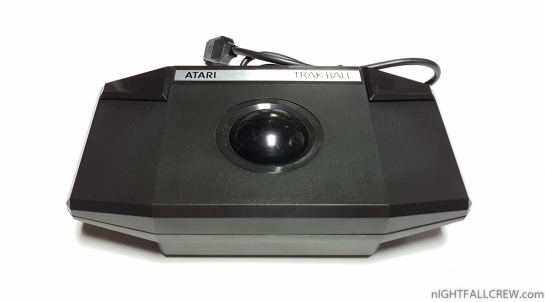
The Atari Trak-Ball is a pointing/movement device consisting of a ball held by a socket containing sensors to detect a rotation of the ball about two axis-like an upside-down mouse with an exposed protruding ball. The user rolls the ball with the palm of the hand while using the fingertips to press the two large buttons.
The Atari Track-Ball is mainly used with games like Centipede, Missile Command, Crystal Castle, etc.
Gallery:
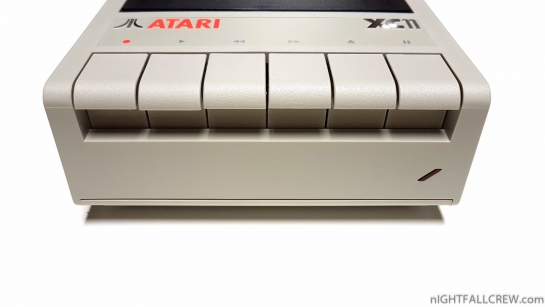
The Atari Tape Recorder Model XC11 can save or load programs/data from magnetic media (audio cassette).
The transfer rate is 600bits per second, so you can record about 100,000 bytes of data on a regular 60 minute cassette.
Unlike the new XC12 model in the XC11 we find the SIO pass through connector so this device can be connected anywhere in the SIO chain.
The power is supplied from the I/O Serial cable (SIO).
Gallery:
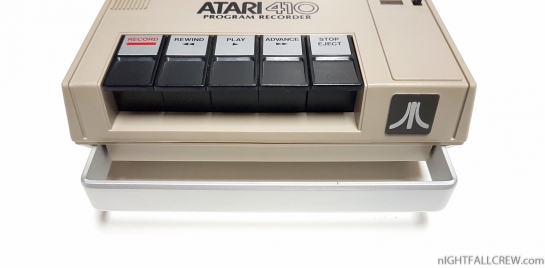
I did not find much information about this specific Atari Tape Recorder Model 410, probably is one of the first models that have been produced for the Atari 400/800 series and does not have the SIO passtrough to connect other external peripherals.
General informations:
The Program Recorder was well built and study with built in power supply and SIO cable, the 410 didn’t need a bukly external power pak like most other Atari 400/800 components, how the SIO cable being built in and the Program Recorder having no daisy chain port on the unit meant that it had to be placed at the end of the SIO chain.
The original idea of the SIO (Serial I/O) port on the Atari computers was that it was to be used only for the Data cassette drive, however its functionality was extended so that it could use all Atari peripherals including disk drives, printers and modem.
The Atari 410/410a had a unique feature exclusively used by Atari. They could play two seperate tracks on a tape, this proved very useful for interactive programs where a user would run a program and would hear audio music/speech while the other track would load the next part of the program.
Gallery:
source: atarimuseum.com
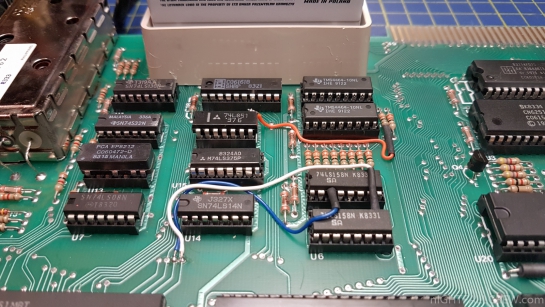
Atari 600XL Repair & Memory Upgrade
Defect:
Repair:
Enhancements:
Gallery:
Recent Comments